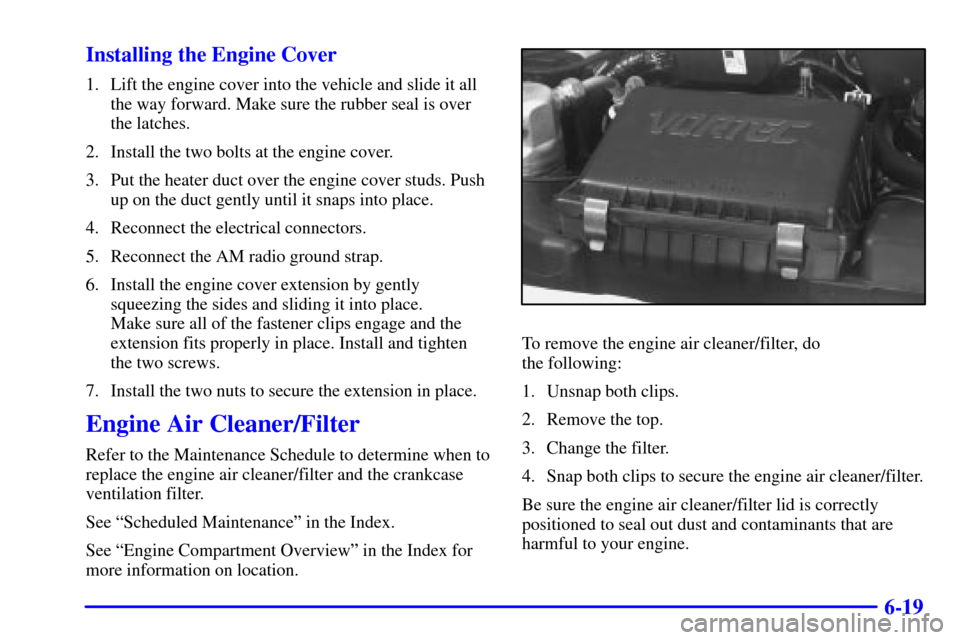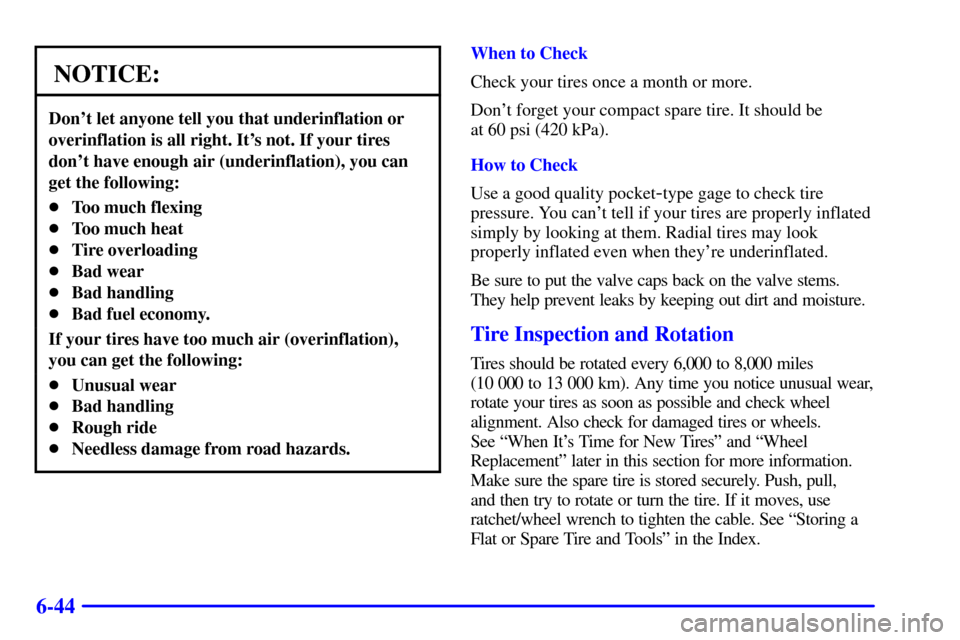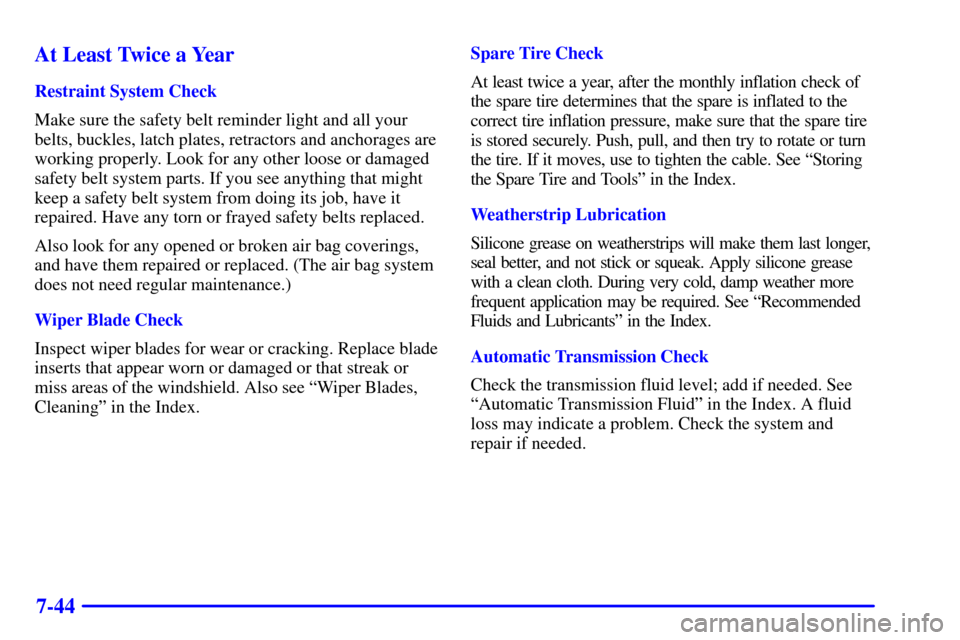Page 250 of 388
5-32
5. Make sure the tire is stored securely. Push, pull, and
then try to rotate or turn the tire. If the tire moves,
use the ratchet/wheel wrench to tighten the cable.
Return the jacking equipment to its proper location.
Compact Spare Tire
Although the compact spare tire was fully inflated when your
vehicle was new, it can lose air after a time. Check the
inflation pressure regularly. It should be 60 psi (420 kPa).
After installing the compact spare on your vehicle, you
should stop as soon as possible and make sure your spare
tire is correctly inflated. The compact spare is made to
perform well at speeds up to 65 mph (105 km/h) for
distances up to 3,000 miles (5 000 km), so you can finish
your trip and have your full
-size tire repaired or replaced
where you want. Of course, it's best to replace your spare
with a full
-size tire as soon as you can. Your spare will last
longer and be in good shape in case you need it again.
Page 268 of 388
6-16
2. Remove the instrument panel extension by removing
the two nuts that secure it in place. The nuts are
located at the bottom of the extension on the driver's
and passenger's side corners.3. Remove the screws located near the top on each side
of the extension. Grasp the extension from both sides
and gently remove it.
Page 271 of 388

6-19 Installing the Engine Cover
1. Lift the engine cover into the vehicle and slide it all
the way forward. Make sure the rubber seal is over
the latches.
2. Install the two bolts at the engine cover.
3. Put the heater duct over the engine cover studs. Push
up on the duct gently until it snaps into place.
4. Reconnect the electrical connectors.
5. Reconnect the AM radio ground strap.
6. Install the engine cover extension by gently
squeezing the sides and sliding it into place.
Make sure all of the fastener clips engage and the
extension fits properly in place. Install and tighten
the two screws.
7. Install the two nuts to secure the extension in place.
Engine Air Cleaner/Filter
Refer to the Maintenance Schedule to determine when to
replace the engine air cleaner/filter and the crankcase
ventilation filter.
See ªScheduled Maintenanceº in the Index.
See ªEngine Compartment Overviewº in the Index for
more information on location.
To remove the engine air cleaner/filter, do
the following:
1. Unsnap both clips.
2. Remove the top.
3. Change the filter.
4. Snap both clips to secure the engine air cleaner/filter.
Be sure the engine air cleaner/filter lid is correctly
positioned to seal out dust and contaminants that are
harmful to your engine.
Page 296 of 388

6-44
NOTICE:
Don't let anyone tell you that underinflation or
overinflation is all right. It's not. If your tires
don't have enough air (underinflation), you can
get the following:
�Too much flexing
�Too much heat
�Tire overloading
�Bad wear
�Bad handling
�Bad fuel economy.
If your tires have too much air (overinflation),
you can get the following:
�Unusual wear
�Bad handling
�Rough ride
�Needless damage from road hazards.
When to Check
Check your tires once a month or more.
Don't forget your compact spare tire. It should be
at 60 psi (420 kPa).
How to Check
Use a good quality pocket
-type gage to check tire
pressure. You can't tell if your tires are properly inflated
simply by looking at them. Radial tires may look
properly inflated even when they're underinflated.
Be sure to put the valve caps back on the valve stems.
They help prevent leaks by keeping out dirt and moisture.
Tire Inspection and Rotation
Tires should be rotated every 6,000 to 8,000 miles
(10 000 to 13 000 km). Any time you notice unusual wear,
rotate your tires as soon as possible and check wheel
alignment. Also check for damaged tires or wheels.
See ªWhen It's Time for New Tiresº and ªWheel
Replacementº later in this section for more information.
Make sure the spare tire is stored securely. Push, pull,
and then try to rotate or turn the tire. If it moves, use
ratchet/wheel wrench to tighten the cable. See ªStoring a
Flat or Spare Tire and Toolsº in the Index.
Page 302 of 388
6-50
Used Replacement Wheels
CAUTION:
Putting a used wheel on your vehicle is
dangerous. You can't know how it's been used or
how far it's been driven. It could fail suddenly
and cause an accident. If you have to replace a
wheel, use a new GM original equipment wheel.
Tire Chains
NOTICE:
Use tire chains only where legal and only when
you must. Use only SAE Class ªSº type chains
that are the proper size for your tires. Install
them on the rear axle tires and tighten them
as tightly as possible with the ends
securely fastened.
Drive slowly and follow the chain manufacturer's
instructions. If you can hear the chains
contacting your vehicle, stop and retighten them.
If the contact continues, slow down until it stops.
Driving too fast or spinning the wheels with
chains on will damage your vehicle.
Page 365 of 388

7-44 At Least Twice a Year
Restraint System Check
Make sure the safety belt reminder light and all your
belts, buckles, latch plates, retractors and anchorages are
working properly. Look for any other loose or damaged
safety belt system parts. If you see anything that might
keep a safety belt system from doing its job, have it
repaired. Have any torn or frayed safety belts replaced.
Also look for any opened or broken air bag coverings,
and have them repaired or replaced. (The air bag system
does not need regular maintenance.)
Wiper Blade Check
Inspect wiper blades for wear or cracking. Replace blade
inserts that appear worn or damaged or that streak or
miss areas of the windshield. Also see ªWiper Blades,
Cleaningº in the Index.Spare Tire Check
At least twice a year, after the monthly inflation check of
the spare tire determines that the spare is inflated to the
correct tire inflation pressure, make sure that the spare tire
is stored securely. Push, pull, and then try to rotate or turn
the tire. If it moves, use to tighten the cable. See ªStoring
the Spare Tire and Toolsº in the Index.
Weatherstrip Lubrication
Silicone grease on weatherstrips will make them last longer,
seal better, and not stick or squeak. Apply silicone grease
with a clean cloth. During very cold, damp weather more
frequent application may be required. See ªRecommended
Fluids and Lubricantsº in the Index.
Automatic Transmission Check
Check the transmission fluid level; add if needed. See
ªAutomatic Transmission Fluidº in the Index. A fluid
loss may indicate a problem. Check the system and
repair if needed.